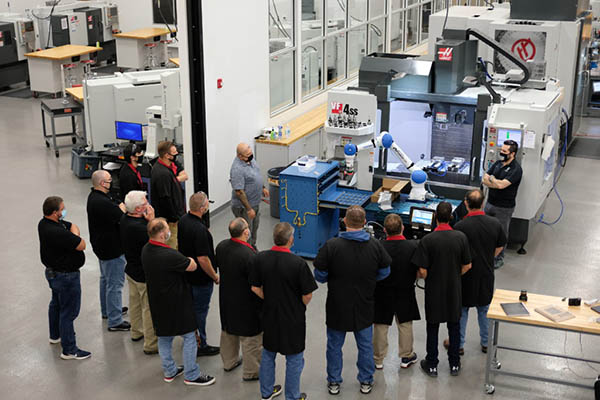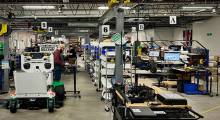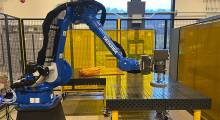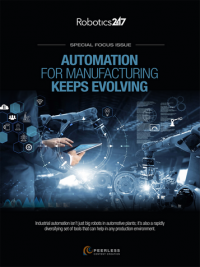In 2019, just prior to the pandemic, many of us were predicting that robots and automation would have a big impact in the new decade that was coming. All of the numbers were pointing to growth, not only in industries that had a long history of using robotics like the manufacturing sector, but in new industries like logistics, which was starting to make bigger investments in robotics. Then COVID-19 hit, and for a while, there was a break in the action, but that all quickly changed.
“The pandemic put the brakes on a lot of stuff early in 2020, but by the end of the year, it was rocketing back. The pandemic accelerated companies' decisions. They were looking at how to automate beforehand.”
So what are some of the key things that are driving this push for robotics as we come out of the pandemic? How will more robotics, not only in our workplaces, but also out in the general public, change how people work and go about their lives?
Here are five things that are leading us toward more robotics in the future and how we can prepare:
1. E-commerce is here to stay
People were already ordering a lot online prior to the pandemic. When the pandemic came, ordering anything and everything online became the norm. Those who had never ordered anything online no longer had an excuse and now that they have tried it, most of them are going to continue to shop that way.
In 2020, consumers spent $861.12 billion online with U.S. merchants, up an incredible 44% year over year, according to Digital Commerce 360.
It is of note that 21.3% of all retail sales were done online in 2020. This is up from 15.8% in 2019 and 14.3% in 2018. According to Digital Commerce 360, the more than five-percentage point gain in e-commerce penetration is by far the biggest year-over-year jump for U.S. retail sales ever recorded.
Overall, online sales accounted for 101% of all gains in U.S. retail in 2020. This means sales through all other channels—stores, catalogs and call centers— declined. Again, this is a historical first where e-commerce accounted for all of the sales gains in U.S. retail.
This growth in e-commerce was not limited to just the U.S. Other regions of the world saw similar pops in e-commerce sales. While worldwide retail sales overall fell 3% to $23.839 trillion, e-commerce sales grew 27.6% to take $4.28 trillion of the overall sales pie. Some countries, like Argentina, saw their retail e-commerce grew by an astounding 79% in 2020.
This growth has lead to a hiring frenzy by companies like Amazon and FedEx, while they have also turned to deploying robotics and automation into their operations. Why? Because the boom in e-commerce is growing faster than firms can hire.

2. More manufacturing to reshore
As the pandemic closed borders and factories around the world, supply chains took a major pounding and continue to do so. This has caused many business executives to rethink their supply chains, and some are even reshoring manufacturing back to the U.S. The Biden administration is also actively encouraging the reshoring efforts through new programs and incentives.
“We had planned to do this for years, but I think the pandemic put an exclamation point on why it’s going to be awesome. Having more flexibility in running a global supply chain is also going to allow us to sleep better, as you can imagine.”
Peloton recently announced that it would build a $400 million factory in Ohio to not only address its growing e-commerce business, but to close the gaps in its supply chain.
A critical component that is allowing manufacturers to return to U.S. is the rise of robotics and automation. By using technology, manufacturers can build at a similar cost structure by building closer to their customers in the states.
3. The shrinking workforce and growing skills gap
Earlier in the year, Deloitte and The Manufacturing Institute came out with a stunning report that the growing U.S. manufacturing skills gap could leave 2.1 million jobs unfilled by 2030 and cost the U.S. economy as much as $1 trillion! Other key points in the report were:
- 36% of U.S. manufacturers believe finding the right talent now is 36% harder than it was in 2018, despite a much-higher unemployment rate (yes, that is 36% twice).
- 71% of U.S. manufacturers say they will have ongoing difficulties in attracting and retaining workers in 2021 and beyond.
- Only 30% of manufacturing professionals are women. In addition, women surveyed were 1.8 times more likely than men to contemplate leaving the industry, citing lack of work-life balance and the need for flexible schedules.
“Given the foundational role the manufacturing sector plays in our nation’s economy, it is deeply concerning that at a time when jobs are in such high demand nationwide, the number of vacant entry-level manufacturing positions continues to grow,” said Paul Wellener, vice chairman and U.S. industrial products and construction leader at Deloitte LLP.
“Every eight seconds, a baby boomer retires.”
Combine this with the problem that the median age of an American working in manufacturing is 44 years old, and older workers are retiring faster than they are being replaced.
This worker shortage has led many corporate leaders to seriously look at adding robotics and automation to their workflows.
4. The rise of the robots
“Worker shortages in manufacturing, warehousing, and other industries are a significant factor in the current expansion of robot use that we're now seeing,” stated Jeff Burnstein, president of the Association for Advancing Automation (A3).
Robots and automation are nothing new. However, what most people don't realize is that the U.S. is not even close to having the level of robot density as other countries, especially those with large manufacturing sectors. This goes against the false narrative that robots destroy manufacturing jobs.
In 2019, over 25% of the South Korean economy was tied to manufacturing. It is not surprising that South Korea has one of the highest densities of robots to employees in the world, according to the International Federation of Robotics (IFR).
For Germany, manufacturing made up over 19% of the economy. For the U.S., though, only 11.39% of economic output in 2019 was linked to manufacturing. So what is the relationship between South Korea's use of robotics and its large manufacturing sector? It is complex, but it does show what could be in the future for the U.S.
In 2020, South Korea crossed 300,000 industrial robots installed, which was double the number of robots in use from five years earlier. In 2020, the U.S. saw a total of 293,200 industrial robots installed. So even though South Korea has a human population of only 16% of that of U.S., it has a larger robot population. It should also be pointed out that in 2020, South Korea reported an unemployment rate of 3.94%.
South Korea has a rapidly aging population. By 2050, over half of the workers in South Korea will be over the age of 50. This means robots are going to be essential to maintain the country's manufacturing sector. This is why South Korea has laid out its “Third Robot Basic Plan,” which pushes for 700,000 robots installed by 2023 and a workforce to support them.
5. Reskilling and upskilling for the 21st century
It should be no surprise that one of the recommendations from the Deloitte and The Manufacturing Institute was for investment in programs that will allow people to reskill and upskill.
The Biden administration's American Jobs Plan is looking to fund numerous workforce development efforts:
- $100 billion in workforce development programs for underserved groups and high school students
- $40 billion investment in a dislocated workers program
- $12 billion in general workforce development
However, the challenge will be getting people into those programs. Small businesses can seldom afford to invest in long-term workforce development and as a result there are less employer-funded training including programs like apprenticeships. Government programs will have to fill the gap through direct programming or investments in partnership programs with third-party vendors.
“We know workforce development works,” stated Karin Norington-Reaves, CEO of the Chicago Cook Workforce Partnership. “For me, it is really about scale and quite frankly the bandwidth of organizations within our network. We will never be able to fully meet the needs of all of the people who so desperately want to work and who need the additional skills. It’s not a question of will people be successful; it’s a question of will they be able to gain access to the program.”
This means that programs will need to be laser-focused on their training, so that they can quickly train individuals and graduate them into jobs. This will allow more individuals to be trained. So how can programs accomplish this? There has been much written on the topic, with these being the biggest keys to success:
- Define strategic workforce and skills planning based on industry needs. Industry leaders need to talk with their local academic partners to ensure current curriculums are leading to Day 1-ready jobs.
- Creating a skills framework for each job role. Discover where there is crossover between skill sets. App developers may already have skills that lead to becoming robot programmers.
- Creation of a standardized skill taxonomy and people profiles beyond company boundaries. The establishment of company-independent “digital skills record” has already started with the rise of so-called “digital badges,” which can be published in a verifiable way on social business networks like LinkedIn.
At organizations like eKentucky Advanced Manufacturing Institute (eKAMI), which re-trains former coal miners in advanced manufacturing and robotics, has been successful by hitting on these key success factors.
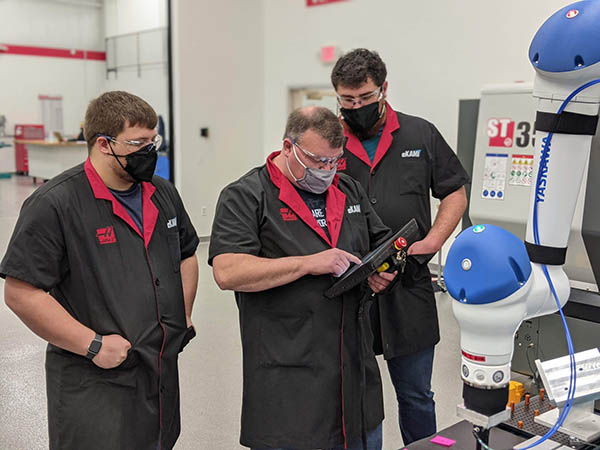
In five to 10 months, depending on the program, eKAMI is able to take a student from not having the needed skills for the new 21st century jobs in manufacturing and robotics to being fully employed. The following are reasons why:
- eKAMI has partnered with many companies to ensure they are training students in the skills needed. Many students are ready to start work prior to graduation because of this alignment. These companies are also now repeat customers of eKAMI and continue to hire from there.
- Many students come to eKAMI with skills from the mining industry that translate well to their new skills in advanced manufacturing and robotics. Instructors leverage these transferable skills to help students quickly pickup their new skills.
- eKAMI students receive credentials from organizations like the National Institute of Metalworking Skills (NIMS) that can be transferred from job to job.
Successful reskilling and upskilling programs will need to move at the speed that industry needs skilled people. There will also need to be ongoing life learning programs to keep employees ahead of the technology curve. Smart investments in programs that produce skilled workers will be critical to keep up with a rapidly changing economy.
The U.S. will need to revamp its education process and ways of thinking if we want to grow in our use of robotics and our ability to use them in this new post-pandemic world. We will need workers who can be quickly given the skill sets they need and then be employed to work with robots in numerous industries, from logistics to manufacturing. We need to realize that robots are not robbing us of our jobs, but creating more specialized positions for workers.

About the author
Aaron Prather is senior technical advisor and R&D evangelist at FedEx. He is a proponent of the intelligent use of robots, software, and re-skilling the workforce. This column reprinted from LinkedIn with the author's permission.
Article topics
Email Sign Up

